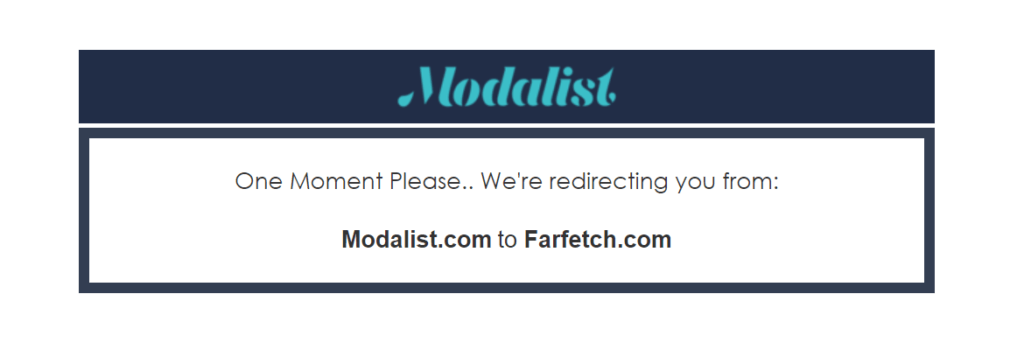The Modalist – Getting Paid for Retail Therapy

Combining the world's top fashion brands and retailers, a robust search engine, and a compelling cash back loyalty program, The Modalist aims to elevate the online shopping experience.
Business Overview
The Modalist is an online luxury fashion marketplace that aggregates over half a million products from 5,000+ partners (some of which are marketplaces themselves) [1]. Founded in 2016 in Columbus, Ohio by entrepreneurs Tina and Bob Fisher, the platform serves as a one-stop-shop for fashion by enabling the customer to search across multiple brands and retailers at once. Once a shopper clicks on a product, however, she’s redirected to the partner’s native site to complete the transaction. While fashion aggregators are not a new concept, the platform is the first in the luxury fashion space to offer cash back on purchases [2]. Cash back rates currently range from 1 to 4% at the likes of Neiman Marcus and Shopbop [3], and balances are disbursed to the shopper on a quarterly basis via check or PayPal [4].
Exhibit 1 – Illustrative Search
Direct competitors in the fashion aggregator space include ShopStyle, Lyst, Spring, and Polyvore. The largest competitor is perhaps the Rakuten-owned cash back and coupons giant, Ebates, which also owns ShopStyle. A point of differentiation for The Modalist, however, is that Ebates (ex-ShopStyle) is not fashion-specific, nor does it enable product searches.
In December 2017, the company launched an influencer affiliate program called the Modalist Social Runway [4], directly competing with ShopStyle’s own highly popular service, ShopStyle Collective. Fashion influencers, by sharing shoppable content on social media posts or blogs that drive traffic to The Modalist’s partners, receive a percentage of completed sales [5]. ShopStyle Collective, in contrast, employs a pay-per-click model that starts at 4-5 cents per click [6].
Value Creation and Value Capture
For the shopper, The Modalist delivers a convenient online product discovery and shopping experience, at a “discounted” price. For its brand and retailer partners, the company drives additional traffic and sales, while incentivizing repeat purchases with its cash back perks. For its affiliates, the Social Runway program enables them to monetize their own platforms and grow.
The company captures value by extracting commissions from its partners, although the exact percentage terms are undisclosed.
Potential Challenges
- Customer Experience: Unlike such fashion platforms as Farfetch, The Modalist relinquishes complete control of the point-of-sale and post-transaction processes. Its partners are responsible for checkout, shipping and handling, and any customer service inquiries. However, this results in an uneven customer experience as a shopper could order five items through The Modalist, initially presented on the same platform, but have to checkout five different times, receive five different confirmation notifications, await five different shipments, and potentially initiate five different returns. There are branding implications as this disruption in the customer journey could prevent shoppers from building loyalty towards the platform as well as debunk its convenience claims if, for instance, the shopper calls The Modalist with a question about her order only to be told that she needs to direct her question to a partner.
- Competition: Low switching costs have resulted in the high propensity of all customers (shoppers, brands and retailers, and affiliates) to multi-home, and the low barriers to entry have resulted in an increasingly crowded market filled with players with relatively little points of differentiation. Moreover, while the cash back is attractive, it’s debatable whether the fundamental value proposition of the feature engenders any meaningful brand loyalty that can be decoupled from price. If not, we would likely see a race to a bottom with the cash back rate as the sole operating lever. In fact, Spring recently began offering a blanket 4% cash back on every purchase and double cash back on select brands[7]. As such, The Modalist should instead seek to differentiate itself outside of the cash back program by delivering a superior customer experience. The lack of an integrated checkout solution (adopted by multiple competitors and the retail standard in the luxury platform space), for example, raises concerns about the company’s strategic focus.
- Disintermediation: While affiliates benefit from access to a large brand and retailer network, and partners can minimize costs associated with identifying the right influencers for their brand and nurturing the relationship, The Modalist runs the risk of being disintermediated once an affiliate reaches scale and amasses the negotiating power to strike deals directly with partners.
Exhibit 2 – Redirect Window
Sources
[1] https://gust.com/companies/modalist-llc
[2] http://www.glossy.co/ecommerce/fashion-search-engine-modalist-is-giving-cash-back-to-luxury-shoppers
[3] https://www.modalist.com/cashback/
[4] http://www.columbusceo.com/business/20171215/briefing-blogging-for-dollars
[5] https://modalistsocialrunway.zendesk.com/hc/en-us/articles/115003441292-What-are-some-of-the-major-advantages-of-the-MSR-program-
[6] https://shopstylecollective.zendesk.com/hc/en-us/articles/213793223-How-do-I-earn-money-with-ShopStyle-Collective-
[7] http://db.glossy.co/retail-redux/retailers-experiment-with-cash-back-loyalty-programs-to-encourage-repeat-shoppers




